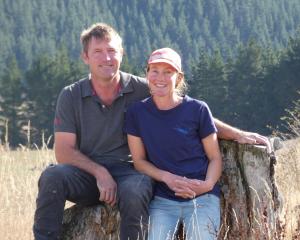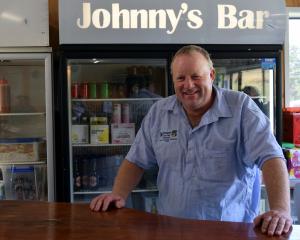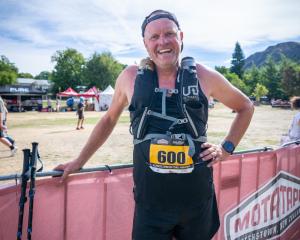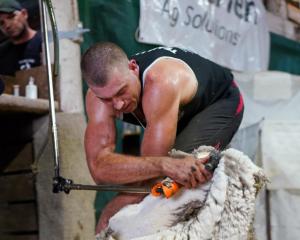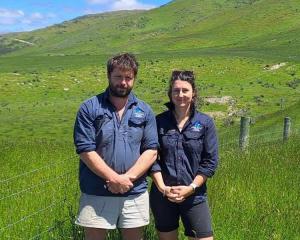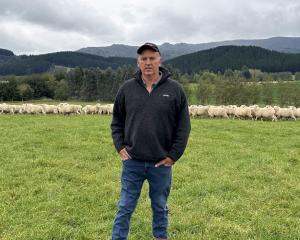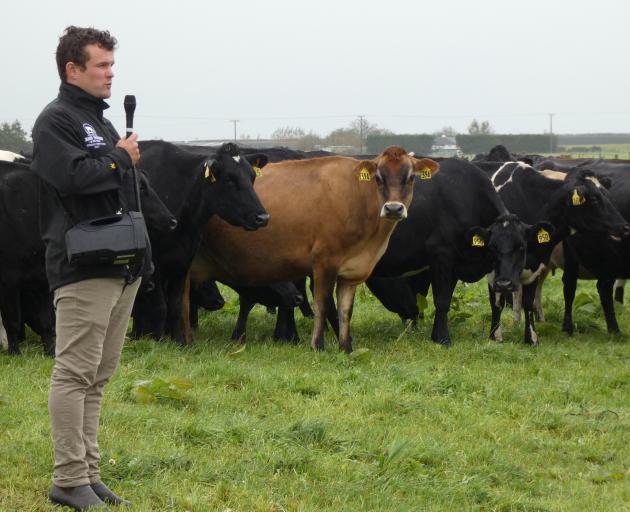
Mid Canterbury sharemilker Will Green has mapped out a course to own a dairy farm in five years, and build a family home with his partner, Sally.
Financially, they’re almost at this stage, but are resisting the urge to jump into the first farm they see. The target is simple: A 600-cow property that’s in tune with his pasture-focused farming and "wealth creation" philosophy.
"If the milk price possibly does what I think it’s going to do next year, I will be about 18 months, to two years away from having 1100 cows, debt-free," he says.
"I’m not quite going to be able to buy a 600-cow farm and the main thing with the intermediate step is I don’t do anything that jeopardises my sharemilking position here as to get a sharemilking job in irrigated Canterbury you basically have to win the lottery, so that’s number one."
Possibly the direction could involve passive investments such as building his lease stock portfolio with Dairy Holdings.
The lower order sharemilker owns 34% of the milk cheque and pays the same proportion for most of the costs at the 270ha DHL Propad farm. The fully owned subsidiary of Dairy Holdings, in Hinds, milks 1060 cows.
He owns 40% of the herd and also has 290 lease cows as well as young stock.
Next season he will have 90% ownership of the herd and receive 47% of milk revenue in an agreement with Dairy Holdings, with the plan to push this out to full herd ownership the following year.
Future options could also involve him leasing a farm short term, maybe within a five-year timeframe. Or possibly he could become an off-farm or silent partner with up-and-coming farmers for another 50:50 sharemilking job.
The passive-income target is to provide a 15%-plus return to grow their equity base and reduce debt.
Last year he bought lease cows for $1600 a head, leveraged them at 50% and with 5% interest payments this left him with about an 11% return.
Below the 15% target, but still a good low-risk return and guaranteed income with little energy expended on his part.
"There’s a lot of exciting opportunities, you just have to think a little bit differently and have not necessarily the finances, but the skill set and the mindset to want to add value."
A good test of his discipline will be to avoid buying a farm before they’re ready.
"Farm ownership’s something I want so bad ... There’s a lot of farms on the West Coast or the North Island and they are actually within reach now. The discipline is to sit tight and keep investing money wisely so we can get to that 600-700 cow property.
"It’s going to give us good returns in an area we would like to live in and also give us scale to employ staff and not be tied to the farm every day and have a good life and work balance."
The 34-year-old has always been a big fan of writing down goals. Every year he sits down to do this, often on the back of an envelope and they’re purposefully kept simple.
A big goal is to harvest and utilise as much pasture as possible and an ambitious target of 80% is put down on paper.
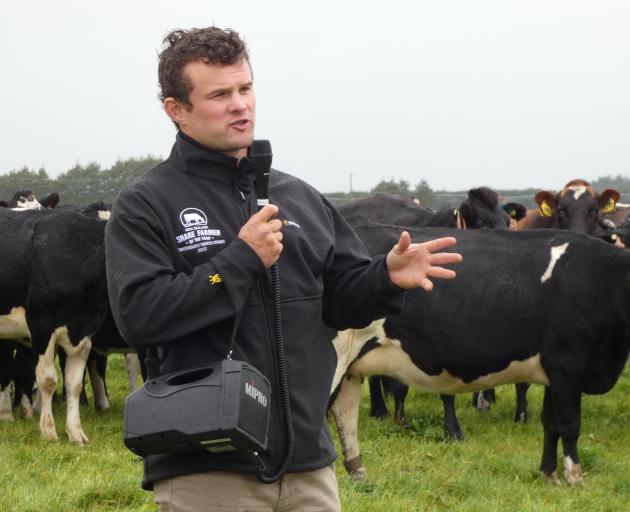
Even on a rainy day or a slow period he can be found jotting goals down and it can be as mundane as washing the yard or the vat. It’s surprisingly how motivated this makes him feel, he says, and gives him a sense of achievement.
"I’ve always had big-term goals, farm ownership is what I’ve wanted to do for as long as I can remember. I think one week I wanted to be a jam maker and the rest of the time I wanted to be a farmer and farm owner. By writing this down yourself you hold yourself accountable and we’ve even stuck our goals and vision statement on the side of the shed on a pretty big board so that all our team can see it and wider people coming on the farm. So we are not only going to hold ourselves accountable for our values and goals but other people can pull us up."
Mr Green grew up on a family farm that was divided between dairying, beef and cropping in the United Kingdom. At Harper Adams University, in Newport, he completed a science and agriculture degree.
In 2009, he came out to New Zealand for a year as part of his industry placement and saw people getting into farm ownership through sharemilking and hard work.
On returning, he started a job as a farm assistant for Kieran and Leonie Guiney at one of their Fairlie farms after cold-calling them. It opened up his eyes to the profitable pasture system.
The following year he was promoted to farm manager, a post he held for a few years before progressing to lower order sharemilking on the same farm for another two seasons and then moving to Hinds in 2020.
Mr Green says he had been fortunate to have great mentors in both the Guineys and Dairy Holdings’ circle of supervisors and system coaches.
He surrounds himself with advisers and has shopped around to get the best bankers, accountants and professionals. Nor has he been been scared to call people up for advice or create new networks.
He has read his fair share of motivation books, but as a sports fan he’s got a lot out of the autobiographies of former All Black coach Steve Hansen, notably that the team comes first and no individual is bigger than the team.
That is why on recruitment he always goes for the person who is the best fit for the team rather than the best individual.
Other favourite reads are books by Sir Alex Ferguson, a believer in the personal touch and getting to know people and Sir Clive Woodward who was an expert in getting people to follow a common goal.
Mr Green has taken all of these mantras to heart with his own team.
A credit to him is that nearly all of his staff have come from word of mouth, with departing workers recommending future employees.
At the start of the season he knew they were going to be short-staffed because of Covid-19 and switched the team on to an hourly rate. While wages might have risen, he has found the migrant workers were looking for work after the busy calving and mating periods and being more productive. Each of them is made responsible for a share of the farm to keep on top of thistle removal and maintain fences.
Great pride is taken on building a team culture and he opens his own books so they can see his finances. This transparency makes them feel involved, he says.
Another achievement is winning the Canterbury/ North Otago Share Farmer of the Year title. That’s earned him a ticket to the grand finals at Christchurch from May 11 to 14.
No stranger to the dais, he was the farmer manager of the year for the region in 2018 and went on to be runner-up in the national final.
At a field day at the Hinds property this month, he told visitors that his focus is on profitable farming year after year and making the most of "every blade of grass" with little grazing waste to get profitable milk.
Chasing milk with extra feed in a high payout year like this one with Fonterra at a mid-range of $9.60/kg is resisted.
"There’s no correlation between production and profit," he says succinctly.
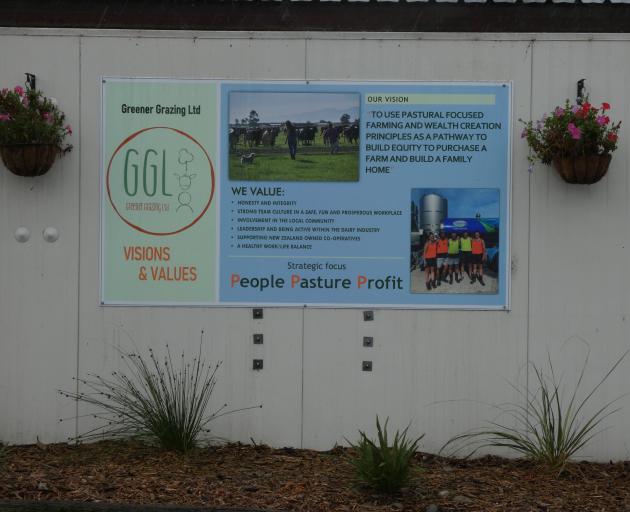
He’d much rather free up cash to build up stock — or service debt — than spend this money.
The 264 effective hectares are fully irrigated by two centre pivots with corner sprinklers and K-line irrigators.
Twice-a-day milking for the first half of the season is reduced to three milkings every two days from January and then once-a-day in April before cows are dried off in June, based on pasture growth and condition scores.
This has paid off with the herd expected to be in milk for about 250 days with an estimated haul this season of 332kg of milk solids per cow and 1035kg per hectare.
This might be lighter than other farms, but the financial results stack up. Their $3275 in gross farm revenue per hectare last season was up on the benchmark $2879/ha average of 22 South Island farms running variable rate sharemilking.
Operating expenses at $1.58/kg of milk solids were on par with the others, but the operating profit of $1211/ha was well up on the $613/ha benchmark.
The stocking rate’s 3.9 cows to the hectare on ryegrass and white clover pastures. Only a smattering of straw is brought in for the shoulder periods, otherwise it’s a homegrown pasture diet.
"Personally as a sharemilker a high stocking rate works in my favour as cows are my assets and I’m trying to grow them as quickly as possible."
Going forward, the Hinds property needs to achieve a nitrate leaching reduction of 15% by 2025 and 35% by 2035.
"The idea of the high stocking rate is to utilise as much pasture in the Spring as possible ... In terms of our nitrogen model in the Spring we will put on nitrogen early to utilise as much pasture as possible and in December we get rid of our culls and then as early as we can for scanning we will drop our stocking rate quite early because Autumn is the biggest risk period for leaching in this system. If we drop our stock then it reduces our requirements to bring in purchased feed and that’s a big way that we are using to manage our production of nitrogen losses so it works like that."
That is coupled with a slower round length, to go into big pasture covers and leave a consistent residual of 1500kg of dry matter /ha, to encourage more grass growth. The focus is on round length rather than grass intake with paddock rounds never faster than 25 days.
Farm walks usually on a Tuesday are followed by observations at a table under the trees to confirm round lengths, which can be tweaked for rainy or dry phases.
For mating, artificial insemination is continued until 1.2 straws are used per cow for about five weeks, followed by Jersey bulls.
Mr Green’s approach on the farm is to be the captain, rolling his sleeves up and leading by example. Going forward, the challenge will be to let go "a little bit" and be more of a coach to manage future passive investments in the immediate term.
Unlike many around him, Mr Green disagrees that it is harder to buy a dairy farm than it once used to be.
"Last year Fonterra did a survey and I think 30% of their suppliers want to sell their farm in the next three years or something like that.
"Whether they actually do or they just want to get away from the problems of staffing them or complying environmentally I don’t know. But that makes a huge opportunity because there’s a lot of people wanting to move and I know the average age of the farmer is lifting so personally I don’t think there’s ever been a better opportunity."
While he concedes it may be difficult to go clean-cut into whole herd ownership, there will be a lot of ways to get into it because farm owners will want young people involved with good environmental and people skills to add value to their business.
"They’re probably going to be quite willing to give a significant chunk or some arrangement for you to get on a farm.
"The way the milk price is going there’s going to be a lot of sharemilkers snapping at the doors."




